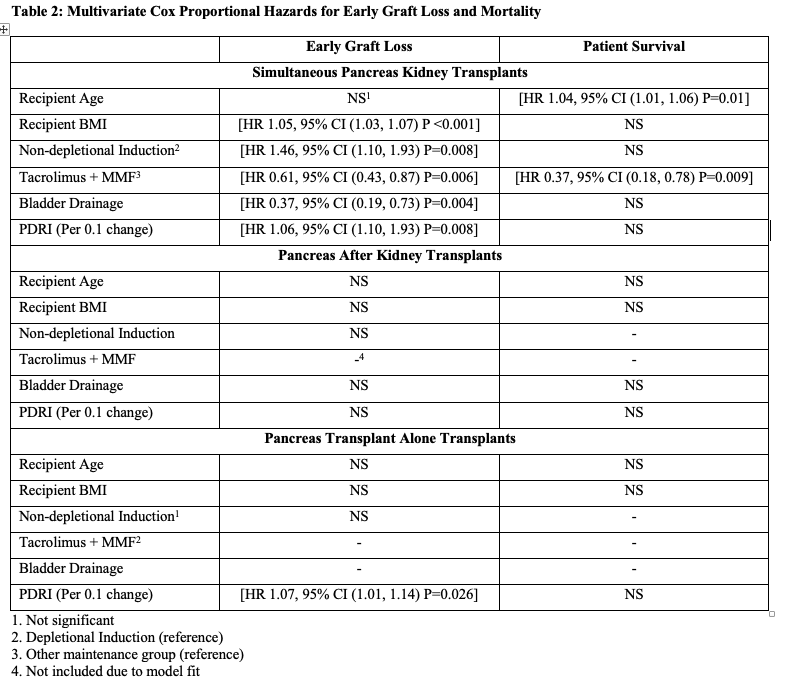Risk Factors for Early Graft Loss and Mortality in Pancreas Transplant Recipients: A Multivariate Analysis of U.S. Transplants
1Medicine, University of Minnesota, Minneapolis, MN, 2Surgery, University of Minnesota, Minneapolis, MN, 3Complex Care Analytics, Fairview Health Services, Minneapolis, MN
Meeting: 2020 American Transplant Congress
Abstract number: 515
Keywords: Pancreas transplantation, Surgical complications, Survival
Session Information
Session Name: Pancreas and Islet: All Topics II
Session Type: Oral Abstract Session
Date: Saturday, May 30, 2020
Session Time: 3:15pm-4:45pm
 Presentation Time: 3:51pm-4:03pm
Presentation Time: 3:51pm-4:03pm
Location: Virtual
*Purpose: There is limited data on trends of early graft loss within 90 days (EGL). Pancreas donor risk index (PDRI) is a scale of pancreas allograft quality that was developed to predict pancreas outcomes at one year. We sought to delineate the trends of pancreas EGL and examine the PDRI predictability of allograft loss and mortality at 90 days in all types of pancreas transplants.
*Methods: Using the SRTR database we studied all primary pancreas transplants between 1987 and 2018 in the united states (n=28,205: SPK 22,587; PAK 3,567; PTA 2,051). Outcomes were reported over 3 eras: 1987-1995 (Pre-Tacrolimus) (n= 4,566), 1996-2005 (n=11,330) and 2006-2018 (n=12,309). Kaplan-Meier curves were generated to delineate the trends of EGL and mortality by transplant type: SPK, PAK and PTA over the three eras. We studied the risk factors for EGL in the most recent era (2006-2018) utilizing Cox proportional hazard models. Models included centers as a random effect and adjusted for recipients age, sex, race, BMI, HLA-MM, diabetes type, induction type, immunosuppression maintenance, duct and venous drainage management and PDRI. Reduced models were used for PAK and PTA.
*Results: EGL rates declined over time for all types of transplants. Mortality declined for SPK and PTA recipients but didn’t change for PAK recipients (Figure 1). For SPK recipients, higher BMI and non-depletional induction were negative predictors of EGL, while Tacrolimus/MMF maintenance and bladder drainage were beneficial. Older recipient age was associated with increased mortality, while Tacrolimus/MMF maintenance was a favorable mortality predictor in SPK recipients. There were 6%, and 7% increased risk of EGL for each 0.1 increase in PDRI in SPK and PTA recipients, respectively. PDRI did not predict 90-day mortality (Table 1).
*Conclusions: The EGL trends improved for all types of pancreas transplants over the three eras. PDRI was an independent predictor of EGL in SPK and PTA but not a predictor of 90-day mortality in any of the groups. Our findings establish the value of PDRI as a predictor of early pancreas outcomes.
To cite this abstract in AMA style:
Riad SM, Adamusiak A, Jackson S, Finger EB, Kandaswamy R. Risk Factors for Early Graft Loss and Mortality in Pancreas Transplant Recipients: A Multivariate Analysis of U.S. Transplants [abstract]. Am J Transplant. 2020; 20 (suppl 3). https://atcmeetingabstracts.com/abstract/risk-factors-for-early-graft-loss-and-mortality-in-pancreas-transplant-recipients-a-multivariate-analysis-of-u-s-transplants/. Accessed December 29, 2025.« Back to 2020 American Transplant Congress


